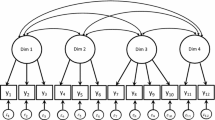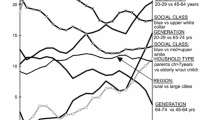Abstract
In this short paper, we outline some considerations on three different procedures for the statistical evaluation of multidimensional well-being, taking the cue from a recent paper of Iglesias et al. There, the authors apply and compare Confirmatory Factor Analysis, the Alkire–Foster counting approach and the Partial Order Approach on real data, pointing out limitations and potentialities of each procedure. To deepen, and partially correct, some of their (albeit interesting) remarks, here we review the fundamental features of those approaches, so as to shed light on their structural differences and to show that they move from, and may lead to, alternative views on well-being.
Similar content being viewed by others
Notes
Here, k is the number of attributes considered in the evaluation exercise.
Here, we refer to CFA in general, not to specific ways to estimate scores, like that used in Iglesias’s paper.
The achievement poset is the set of the achievement profiles, partially ordered in such a way that if profile a has “better” scores than profile b on the same attributes, than a is globally “better” than b (see Fattore (2016) for details).
References
Alkire, S., & Foster, J. (2011). Counting and multidimensional poverty measurement. Journal of Public Economics, 95(7–8), 476–487.
Alkire, S., & Foster, J. (2011). Understandings and misunderstandings of multidimensional poverty measurement. Journal of Economic Inequality, 9(2), 289–314.
Bollen, K. A. (1989). Structural equations with latent variables. New York: Wiley.
Bubley, R., & Dyer, M. (1999). Faster random generation of linear extensions. Discrete Mathematics, 201, 81–88.
Bruggemann, R., & Patil, G. P. (2011). Ranking and prioritization for multi-indicator systems. New York: Springer-Verlag.
Bruggemann, R., Restrepo, G., Voigt, K., & Annoni, P. (2013). Weighting intervals and ranking. Exemplified by leaching potential of pesticides. MATCH Communications in Mathematical and in Computer Chemistry, 69, 413–432.
Bruggemann, R., & Carlsen, L. (2017). Incomparable: What now, IV. Incomparabilities: A Modelling challenge. In M. Fattore & R. Bruggemann (Eds.), Partial order concepts in applied sciences (pp. 35–47). Cham, Switzerland: Springer.
Fattore, M. (2008). Hasse diagrams, poset theory and fuzzy poverty measures, Rivista Internazionale di Scienze Sociali 1/2008.
Fattore, M., Maggino, F., & Greselin, F. (2011). Socio-economic evaluation with ordinal variables: Integrsting counting and poset approaches. Statistica & applicazioni, Special Issue 2011, 31–42.
Fattore, M., & Maggino, F. (2014). Partial orders in socio-economics: A practical challenge for poset theorists or a cultural challenge for social scientists? In R. Bruggemann, L. Carlsen, & J. Wittmann (Eds.), Multi-indicator systems and modelling in partial order. Berlin: Springer.
Fattore, M. (2016). Partially ordered sets and the measurement of multidimensional ordinal deprivation. Social Indicators Research, 128(2), 835–858.
Fattore, M., & Arcagni, A. (2016). A reduced posetic approach to the measurement of multidimensional ordinal deprivation. Social Indicators Research. doi:10.1007/s11205-016-1501-4.
Iglesias, K., Suter, C., Beycan, T., & Vani, B. P. (2016). Exploring multidimensional well-being in Switzerland. Social Indicators Research. doi:10.1007/s11205-016-1452-9.
Madden, D. (2010). Ordinal and cardinal measures of health inequality: An empirical comparison. Health Economics, 19, 243–250.
Schoenemann, P. H., & Steiger, J. H. (1978). On the validity of indeterminate factor scores. Bulletin of the Psychonomic Society, 12(4), 287–290.
Author information
Authors and Affiliations
Corresponding author
Rights and permissions
About this article
Cite this article
Fattore, M., Maggino, F. Some Considerations on Well-Being Evaluation Procedures, Taking the Cue from “Exploring Multidimensional Well-Being in Switzerland: Comparing Three Synthesizing Approaches”. Soc Indic Res 137, 83–91 (2018). https://doi.org/10.1007/s11205-017-1634-0
Accepted:
Published:
Issue Date:
DOI: https://doi.org/10.1007/s11205-017-1634-0




